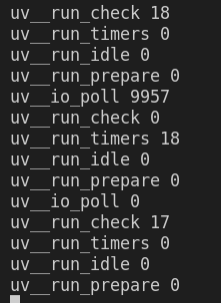使用 ebpf 监控 Node.js 事件循环的耗时
前言:强大的 ebpf 使用越来越广,能做的事情也越来越多,尤其是无侵入的优雅方式更加是技术选型的好选择。本文介绍如何使用 ebpf 来监控 Node.js 的耗时,从而了解 Node.js 事件循环的执行情况。不过这只是粗粒度的监控,想要精细地了解 Node.js 的运行情况,需要做的事情还很多。
在 Node.js 里,我们可以通过 V8 Inspector 的 cpuprofile 来了解 JS 的执行耗时,但是 cpuprofile 无法看到 C、C++ 代码的执行耗时,通常我们可以使用 perf 工具来或许 C、C++ 代码的耗时,不过这里介绍的是通过 ebpf 来实现,不失为一种探索。首先来看一下对 poll io 阶段的监控。先定义一个结构体用于记录耗时。
struct event
{
__u64 start_time;
__u64 end_time;
};接着写 bpf 程序。
#include <linux/bpf.h>
#include <linux/ptrace.h>
#include <bpf/bpf_helpers.h>
#include <bpf/bpf_tracing.h>
#include "uv.h"
#include "uv_uprobe.h"
char LICENSE[] SEC("license") = "Dual BSD/GPL";
#define MAX_ENTRIES 10240
// 用于记录数据
struct {
__uint(type, BPF_MAP_TYPE_HASH);
__uint(max_entries, MAX_ENTRIES);
__type(key, __u32);
__type(value, const char *);} values SEC(".maps");
// 用于输入数据到用户层
struct {
__uint(type, BPF_MAP_TYPE_PERF_EVENT_ARRAY);
__uint(key_size, sizeof(__u32));
__uint(value_size, sizeof(__u32));} events SEC(".maps");static __u64 id = 0;SEC("uprobe/uv__io_poll")int BPF_KPROBE(uprobe_uv__io_poll, uv_loop_t* loop, int timeout){
__u64 current_id = id;
__u64 time = bpf_ktime_get_ns();
bpf_map_update_elem(&values, ¤t_id, &time, BPF_ANY);
return 0;
}
SEC("uretprobe/uv__io_poll")
int BPF_KRETPROBE(uretprobe_uv__io_poll){
__u64 current_id
__u64 current_id = id;
__u64 *time = bpf_map_lookup_elem(&values, ¤t_id);
if (!time) {
return 0;
}
struct event e;
// 记录开始时间和结束时间
e.start_time = *time;
e.end_time = bpf_ktime_get_ns();
// 输出到用户层
bpf_perf_event_output(ctx, &events, BPF_F_CURRENT_CPU, &e, sizeof(e));
bpf_map_delete_elem(&values, ¤t_id);
id++;
return 0;
}最后编写使用 ebpf 程序的代码,只列出核心代码。
#include <errno.h>
#include <stdio.h>
#include <unistd.h>
#include <sys/resource.h>
#include <bpf/libbpf.h>
#include "uv_uprobe.skel.h"
#include "uprobe_helper.h"
#include <signal.h>
#include <bpf/bpf.h>
#include "uv_uprobe.h"
// 输出结果函数
static void handle_event(void *ctx, int cpu, void *data, __u32 data_sz){
const struct event *e = (const struct event *)data;
printf("%s %llu\n", "poll io", (e->end_time - e->start_time) / 1000 / 1000);
}
int main(int argc, char **argv){
struct uv_uprobe_bpf *skel;
long base_addr, uprobe_offset;
int err, i;
struct perf_buffer_opts pb_opts;
struct perf_buffer *pb = NULL;
// 监控哪个 Node.js 进程
char * pid_str = argv[1];
pid_t pid = (pid_t)atoi(pid_str);
char execpath[500];
// 根据 pid 找到 Node.js 的可执行文件
int ret = get_pid_binary_path(pid, execpath, 500);
// 需要监控的函数,uv__io_poll 是处理 poll io 阶段的函数
char * func = "uv__io_poll";
// 通过可执行文件获得函数的地址
uprobe_offset = get_elf_func_offset(execpath, func);
// 加载 bpf 程序到内核
skel = uv_uprobe_bpf__open();
err = uv_uprobe_bpf__load(skel);
// 挂载监控点
skel->links.uprobe_uv__io_poll = bpf_program__attach_uprobe(skel->progs.uprobe_uv__io_poll,
false /* not uretprobe */,
-1,
execpath,
uprobe_offset);
skel->links.uretprobe_uv__io_poll = bpf_program__attach_uprobe(skel->progs.uretprobe_uv__io_poll,
true /* uretprobe */,
-1 /* any pid */,
execpath,
uprobe_offset);
// 设置回调处理 bpf 的输出
pb_opts.sample_cb = handle_event;
pb_opts.lost_cb = handle_lost_events;
pb = perf_buffer__new(bpf_map__fd(skel->maps.events), PERF_BUFFER_PAGES,
&pb_opts);
printf("%-7s %-7s\n", "phase", "interval");
for (i = 0; ; i++) {
// 等待 bpf 的输出,然后执行回调处理,基于 epoll 实现
perf_buffer__poll(pb, PERF_POLL_TIMEOUT_MS);
}
}编译以上代码,然后启动一个 Node.js 进程,接着把 Node.js 进程的 pid 作为参数执行上面代码,就可以看到 poll io 阶段的耗时,通常,如果 Node.js 里没有任务会阻塞到 epoll_wait 中,所以我们无法观察到耗时。我们只需要在代码里写个定时器就行。
setInterval(() => {}, 3000);
我们可以看到 poll io 耗时在 3s 左右,因为有定时器时,poll io 最多等待 3s 后就会返回,也就是整个 poll io 阶段的耗时。了解了基本的实现后,我们来监控整个事件循环每个阶段的耗时。原理是类似的。先定义一个处理多个阶段的宏。
#define PHASE(uprobe) \
uprobe(uv__run_timers) \
uprobe(uv__run_pending) \
uprobe(uv__run_idle) \
uprobe(uv__run_prepare) \
uprobe(uv__io_poll) \
uprobe(uv__run_check) \
uprobe(uv__run_closing_handles)接着改一下 bpf 代码。
#define PROBE(type) \
SEC("uprobe/" #type) \
int BPF_KPROBE(uprobe_##type) \
{ \
char key[20] = #type; \
__u64 time = bpf_ktime_get_ns(); \
bpf_map_update_elem(&values, &key, &time, BPF_ANY); \
return 0; \
} \
SEC("uretprobe/" #type) \
int BPF_KRETPROBE(uretprobe_##type) \
{ \
char key[20] = #type; \
__u64 *time = bpf_map_lookup_elem(&values, &key); \
if (!time) { \
return 0; \
} \
struct event e = { \
.name=#type \
}; \
e.start_time = *time; \
e.end_time = bpf_ktime_get_ns(); \
bpf_perf_event_output(ctx, &events, BPF_F_CURRENT_CPU, &e, sizeof(e)); \
bpf_map_delete_elem(&values, key); \
return 0; \
}
PHASE(PROBE)我们看到代码和之前的 bpf 代码是一样的,只是通过宏的方式,方便定义多个阶段,避免重复代码。主要了使用 C 的一些知识。#a 等于 "a",a##b 等于ab,"a" "b" 等于 "ab"("a" "b" 中间有个空格)。同样,写完 bpf 代码后,再改一下主程序的代码。
#define ATTACH_UPROBE(type) \
do \
{ char * func_##type = #type; \
uprobe_offset = get_elf_func_offset(execpath, func_##type); \
if (uprobe_offset == -1) { \
fprintf(stderr, "invalid function &s: %s\n", func_##type); \
break; \
} \
fprintf(stderr, "uprobe_offset: %ld\n", uprobe_offset);\
skel->links.uprobe_##type = bpf_program__attach_uprobe(skel->progs.uprobe_##type,\
false /* not uretprobe */,\
pid,\
execpath,\
uprobe_offset);\
skel->links.uretprobe_##type = bpf_program__attach_uprobe(skel->progs.uretprobe_##type,\
true /* uretprobe */,\
pid /* any pid */,\
execpath,\
uprobe_offset);\
} while(false);
PHASE(ATTACH_UPROBE)同样,代码还是一样的,只是变成了宏定义,然后通过 PHASE(ATTACH_UPROBE) 定义重复代码。这里使用了 do while(false) 是因为如果某个阶段的处理过程有问题,则忽略,因为我们不能直接 return,所以 do while 是比较好的实现方式。因为在我测试的时候,有两个阶段是失败的,原因是找不到对应函数的地址。最后写个测试代码。
function compute() {
let sum = 0;
for(let i = 0; i < 10000000; i++) {
sum += i;
}
}
setInterval(() => {
compute();
setImmediate(() => {
compute();
});
}, 10000)执行后看到输出。
后记:本文大致介绍了基于 ebpf 实现对 Node.js 事件循环的耗时监控,这只是非常初步的探索,如果你有好的想法欢迎交流。
